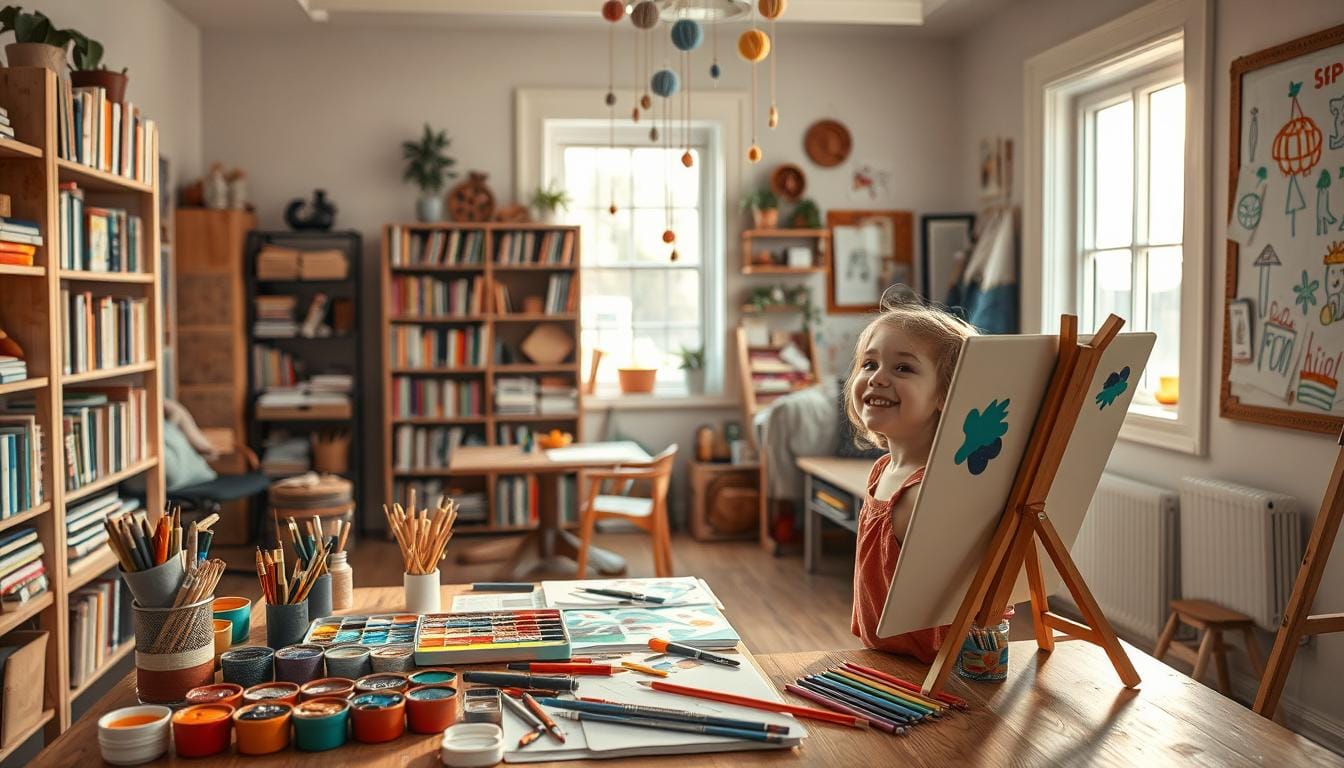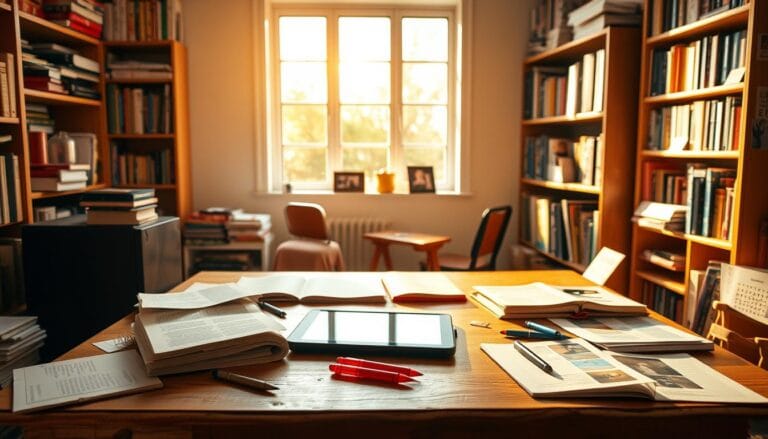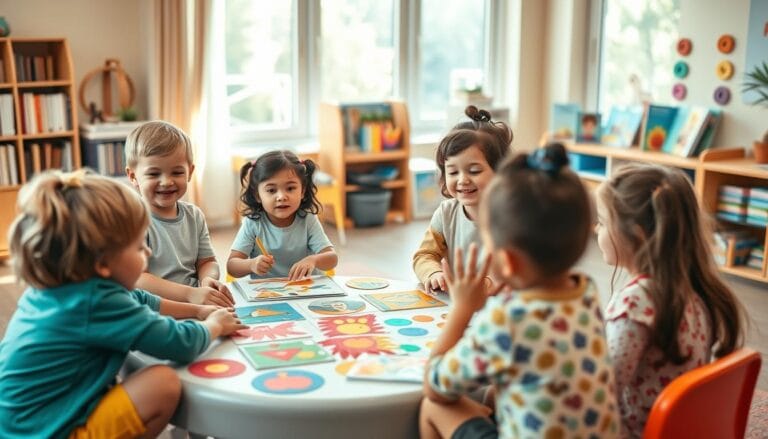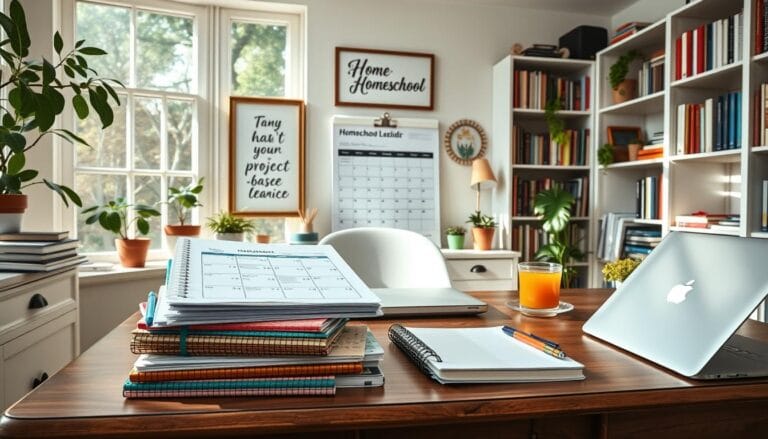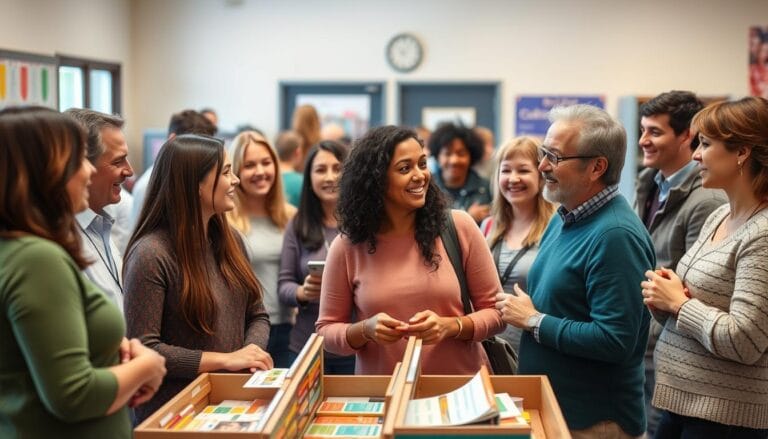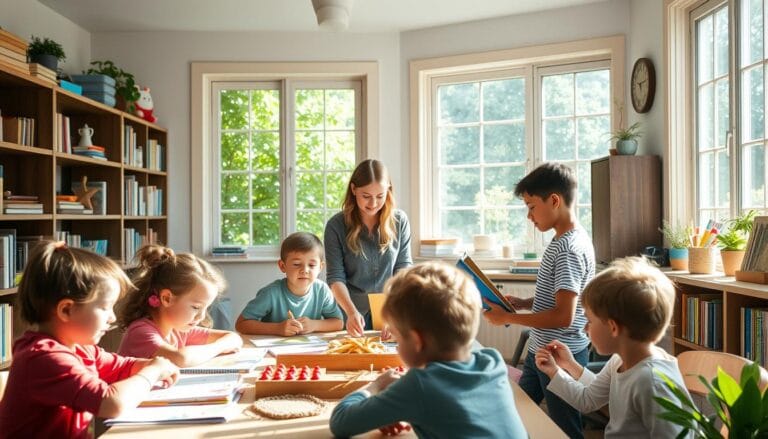Homeschooling as a Drawing: Creative Learning Tips
In a world where education is often confined to the walls of a classroom, homeschooling emerges as a vibrant canvas that allows for creativity and personalized instruction. Imagine a learning environment where your child’s curiosity shapes their educational journey, empowering them with both knowledge and artistic expression. Much like a drawing, homeschooling invites you to sketch a unique educational experience tailored to your child’s interests and needs. With parent-led teaching at the forefront, families can explore a diverse array of subjects in ways that resonate deeply with each learner. This approach fosters not only academic skills but also educational autonomy, encouraging students to take ownership of their learning process. In this article, we will delve into creative tips and strategies to turn homeschooling into an engaging and artistic adventure, where the possibilities for exploration are endless.
Every blank page holds a world of possibility. When you embrace alternative education through home-based learning, art becomes more than just a subject—it’s a transformative journey of discovery and self-expression.
Homeschooling parents often feel uncertain about teaching art, with 75% expressing inadequacy in painting or drawing. But art isn’t about perfection—it’s about exploration and growth. Your home can become a vibrant studio where creativity knows no boundaries.
Art education has been a powerful learning method for centuries. By integrating drawing into your homeschool curriculum, you unlock unique opportunities for your child’s cognitive and emotional development. From tracing large maps to experimenting with colored pencils, each artistic activity builds critical skills.
Research suggests children benefit immensely from structured art experiences. The Weekly Art program offers 34 lessons, with instructional videos typically under 15 minutes—perfect for maintaining young learners’ engagement. Recommended weekly art sessions range from 1 to 1.5 hours, providing ample time for creative exploration.
By embracing art in home-based learning, you’re not just teaching technique—you’re nurturing imagination, building confidence, and creating a lifelong love for creative expression.
Table of Contents
Understanding the Power of Art in Home Education
Art makes homeschooling lively and fun. Unschooling sees art as a key tool for learning, beyond just school. Your home can turn into a creative space where kids learn through art.
Art lets kids dive into their interests and grow important skills. With homeschooling, you can make learning fun and personal.
Benefits of Artistic Expression
Art has many benefits for homeschoolers:
- Boosts creativity and problem-solving
- Improves fine motor skills
- Offers a way to express feelings
- Combines different subjects
Developing Critical Thinking Through Art
“Art enables us to find ourselves and lose ourselves at the same time.” – Thomas Merton
Art projects help students think deeply and share ideas. They learn to:
- Notice details
- See connections
- Try new ways to solve problems
Building Emotional Intelligence
Art is a special way for kids to explore their feelings. Through art, they grow in:
- Self-awareness
- Empathy
- Emotional control
Homeschool art programs change learning into a fun and exciting adventure.
Essential Art Supplies for Your Homeschool Space
Setting up an inspiring art space is key for a flexible homeschool curriculum. Your art area should be both useful and fun. It should spark creativity and keep things organized.
When you’re setting up your art space, think about these important things:
- Dedicated workspace with good lighting
- Organized storage solutions
- Protective covering for surfaces
- Easy-to-access supply containers
For your homeschool space, you’ll need a wide range of art supplies. These should help your students explore different art forms:
| Supply Category | Recommended Items |
|---|---|
| Drawing Basics | Pencils, erasers, sketchpads, colored pencils |
| Painting Supplies | Watercolors, brushes, watercolor paper, fixative spray |
| Safety Supplies | Rounded scissors, washable markers, aprons |
“Art supplies are the tools that transform imagination into reality” – Professional Art Educator
For a self-paced learning experience, choose quality supplies from trusted places like Dick Blick and Utrecht. The right materials will help your curriculum grow and inspire creativity.
Make sure to organize your supplies well. Use clear, labeled containers. Create a space that makes art fun and easy for your young artists.
Homeschooling as a Drawing: Core Teaching Approaches
Creativity turns learning into an active journey. Drawing is more than art; it’s a tool for learning. It helps your child learn in their way.
Using drawing as a main teaching method opens new ways to learn. Kids naturally get complex ideas through pictures. This makes learning fun and easy to understand.
Setting Up Daily Drawing Routines
Regular drawing helps kids grow in discipline and creativity. Here are some tips:
- Dedicate 15-30 minutes daily to drawing
- Create a comfortable, well-lit drawing space
- Use varied drawing prompts to maintain interest
- Encourage free expression alongside structured exercises
Integrating Drawing with Core Subjects
Drawing connects different subjects, making learning exciting. For example:
- Mathematics: Draw geometric shapes to understand spatial relationships
- Science: Sketch botanical illustrations or animal anatomies
- History: Create visual timelines and historical scene representations
- Language Arts: Illustrate story scenes to enhance comprehension
Assessment and Progress Tracking
Keeping track of artistic growth needs a careful eye. Use portfolios, regular skill checks, and talk about their creative path.
“Drawing is not about perfection, but about expression and continuous learning.” – Art Education Expert
Adding drawing to your homeschooling makes learning rich and fun. It celebrates each child’s creativity and supports all-around learning.
Creating a Cross-Disciplinary Art Curriculum
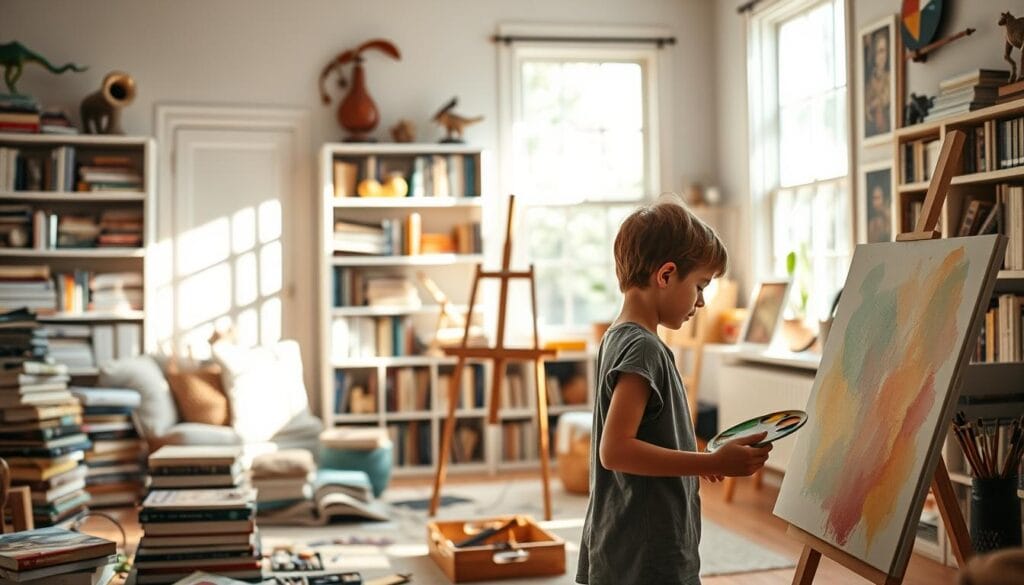
Art makes learning in homeschooling more exciting. It connects different subjects through creativity. This way, learning becomes a fun journey where art and knowledge meet.
Using a cross-disciplinary art curriculum has many benefits:
- Increases student engagement by 30%
- Improves critical thinking skills
- Develops emotional intelligence
- Enhances problem-solving capabilities
Art helps students understand complex ideas in a new way. For example, history can be shown through art from different times. Science can be explained through detailed drawings.
“Art enables us to find ourselves and lose ourselves at the same time.” – Thomas Merton
When planning your homeschooling art curriculum, keep these tips in mind:
- Select diverse art mediums
- Create interdisciplinary projects
- Encourage experimental learning
- Track student progress through portfolios
Studies show that art in learning can boost grades by 20% in related subjects. By using a cross-disciplinary approach, you make learning more engaging and interactive.
Fostering Creativity Through Different Art Mediums
Exploring different art mediums is key in home-based learning and unschooling. It lets kids discover new ways to express themselves. This unlocks their creative potential.
Art education is a great chance for young learners. Studies show that kids who learn through arts are 3.6 times more likely to excel in school. This highlights the value of offering a variety of artistic experiences.
Traditional Drawing Materials
Traditional drawing tools are essential for artistic growth. They help kids develop basic skills and learn various techniques. Setting up an art supply station with:
- Graphite pencils of varying hardness
- Colored pencils
- Charcoal sticks
- Sketch pads
- Erasers and sharpeners
Digital Art Tools and Resources
Digital platforms open up new creative avenues in home-based learning. They bring technology into art education, allowing kids to try digital drawing and multimedia art.
| Digital Art Tool | Age Group | Key Features |
|---|---|---|
| Procreate | 10-18 years | Professional-grade digital painting |
| Krita | 8-16 years | Free open-source drawing software |
| Adobe Fresco | 12-18 years | Realistic drawing and painting experience |
Mixed Media Exploration
Unschooling encourages learning through exploration. Mixed media art lets kids mix different materials and techniques. It boosts creativity and critical thinking.
“Art enables us to find ourselves and lose ourselves at the same time.” – Thomas Merton
By using various art mediums, you create a lively learning space. It supports artistic growth, encourages trying new things, and helps kids on their creative paths.
Building Technical Skills and Artistic Confidence
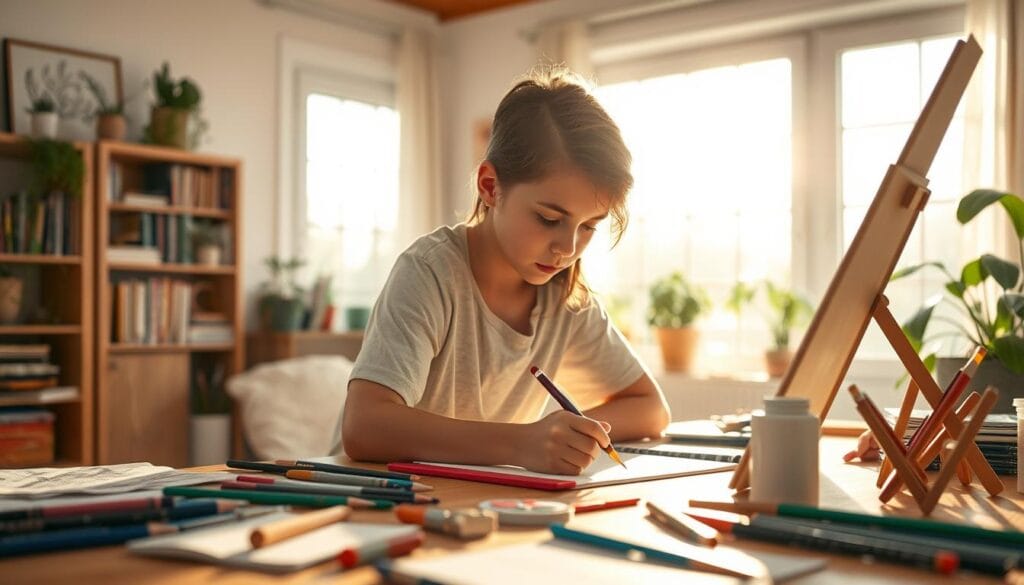
Learning to draw is a journey of self-discovery for homeschooled kids. Personalized lessons help parents create a supportive space. This space helps build drawing skills and boosts confidence.
Here are some ways to improve artistic skills:
- Break down hard drawing steps into easy ones
- Give feedback that is specific and helpful
- Always celebrate each child’s unique art
Teaching art yourself has big benefits. You can tailor lessons to fit your child’s needs and interests. Studies show that regular drawing exercises can improve:
- Fine motor skills
- Understanding of space
- Ability to observe
“Artistic confidence grows when children feel supported and encouraged to explore their creativity.” – Art Education Expert
To create a supportive learning space, consider these steps:
- Provide a variety of art materials
- Set reachable goals
- Keep track of progress in a portfolio
Keeping track of progress is key to building confidence. A simple dashboard can help you and your child set weekly goals. This keeps the motivation to grow in artistic skills.
The aim is not to be perfect but to explore. Every drawing is a step towards understanding and expressing oneself better.
Incorporating Art History and Cultural Studies
Art history is a window into human creativity and culture. Homeschooling can turn learning about art into a fun, flexible curriculum. It sparks curiosity and deep understanding.
Learning about art at your own pace lets students explore artistic traditions and movements. The world of art offers amazing chances for deep learning.
Famous Artists and Their Techniques
Discovering famous artists is an adventure of inspiration and skill. Students can learn by:
- Analyzing signature painting styles
- Recreating iconic artwork
- Studying biographical contexts
- Comparing artistic methodologies
Global Art Traditions
Cultural art traditions give deep insights into human experiences. Your flexible curriculum can include:
- Indigenous art from different continents
- Traditional crafting techniques
- Symbolic representations in art
- Ceremonial and spiritual artistic expressions
Historical Art Movements
Understanding art history helps students see creativity through time. By exploring movements like Renaissance, Impressionism, and Modernism, learners get insights into social and cultural changes.
“Art is not what you see, but what you make others see.” – Edgar Degas
Your self-paced learning lets students dive deep into each art period. They develop a deep understanding through personal exploration and reflection.
Supporting Self-Expression and Individual Growth
Teaching your child to create is more than just showing them how. It’s about making a space where they can be themselves and show their art. This lets them grow in their own way.
Studies show that art changes kids in big ways:
- Art helps kids think better
- It makes them understand their feelings better
- It helps them solve problems
Make your homeschooling special by supporting their art. Children do best when they know their art is seen and loved.
“Creativity is intelligence having fun” – Albert Einstein
Here are ways to help your child feel more confident in their art:
- Make a special art area at home
- Give them lots of different art supplies
- Have art shows regularly
- Give them feedback that is kind and helpful
Research shows that art is key for kids. It boosts their self-confidence and helps them talk better. About 70% of teachers agree that art is great for communication.
Your main job is to help your child love making art. This way, they grow not just in art, but in confidence, feelings, and new ideas.
Conclusion: Nurturing Artistic Development at Home
Homeschooling is a great way to help your child grow creatively. It turns your home into a place where learning and art meet. Studies show that art makes kids think better, solving problems 30% more effectively.
Creating a home learning space can help your child grow. With the right art supplies and projects, their creativity will soar. Kids become more innovative and confident when they have many art materials to play with.
Art is more than just making pretty pictures. It helps kids talk better, feel their emotions, and get ready for a world that loves creativity. Art projects can also make teamwork better by up to 40%.
Keep supporting your child’s creative journey. By making art a part of their learning, you turn school into an exciting adventure. This prepares them for whatever comes next.


